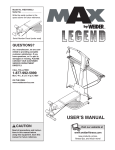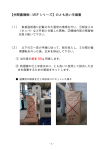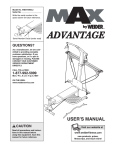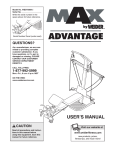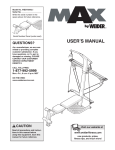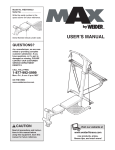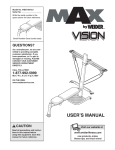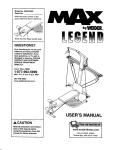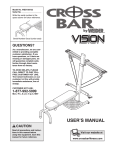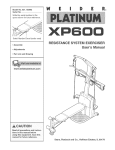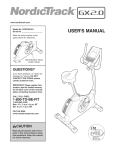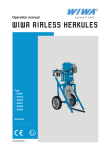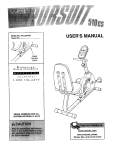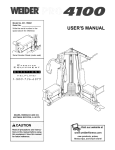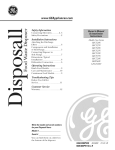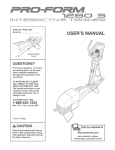Download WEIGHT SYSTEM EXERCISER User`s Manual
Transcript
Model No. 831.15392.2 Serial No. Write the serial number in the space above for reference, Serial Number Decal (under seat) o Assembly Adjustments WEIGHT SYSTEM EXERCISER User's Manual Part List and Drawing ,&CAUTION Read all precautions and instructions in this manual before using this equipment. Save this manual for future reference. Sears, Roebuck and Co., Hoffman Estates, IL 60179 TABLE OF CONTENTS WARNING DECAL PLACEMENT ............................................................. IMPORTANT PRECAUTIONS ................................................................ BEFORE YOU BEGIN ...................................................................... ASSEMBLY ............................................................................... ADJUSTMENTS .......................................................................... CABLE DIAGRAM ......................................................................... EXERCISE GUIDELINES .................................................................. ORDERING REPLACEMENT PARTS .................................................. FULL ONE-YEAR WARRANTY ...................................................... Note: A PART IDENTIFICATION CHART and a PART LIST/EXPLODED this manual. Remove the PART IDENTIFICATION ning assembly, WARNING 2 3 4 5 13 16 17 Back Cover Back Cover DRAWING are attached in the center of CHART and PART LIST/EXPLODED DRAWING before begin- DECAL PLACEMENT The decals shown here have been placed on the resistance system. If a decal is missing or illegible, please call toll-free 1-877-992-5999, Monday through Friday, 6 a.m. until 6 p.m. Mountain Time, to order a free replace= ment decal. Apply the decal in the location shown. hands and ngers clear of area. Read user's manual and follow all warnings and operating instructions prior to use. I Doisuse of thischildren product on may serious injury. I not allow or result aroundin machine. Replace label if damaged, illegible, or removed. J 2 iMPORTANT PRECAUTIONS kWARNi NG: Toreduce the risk ofserious injury, read the following before using the resistance 1. 2. 3. 4. 5. 6. 7. important precautions system. Read all instructions in this manual before 12. Pull on the low pulley cable only while sitting using the resistance system. Use the resist ...................... on the base plate. ante system only as described in this manual. Pull on the high pulley cables only while sitting on the bench, with the seat in one of the it is the responsibility of the owner to ensure three positions closest to the upright base, that all users of the resistance system are or while standing on the base plate. adequately informed of all precautions. 13. The resistance system is designed to be The resistance system is intended for home used with the included resistance, and the use only. Do not use the resistance system in resistance included with a MAX by WELDER any commercial, rental, or institutional setting. MAX PACK. Do not use the resistance system with any other type of resistance. Use the resistance system only on a level surface. Cover the floor beneath the resist14. When adding resistance, both ends of the ance system to protect the floor, resistance bars must rest under the two "U"channels. Add and remove resistance bars from the "U'-channels one resistance bar at Make sure that all parts are properly tighta time. ened each time the resistance system is used. Replace any worn parts immediately. 15. Keep clear of the area around the "U'-chanKeep children under 12 and pets away from nels while the resistance system is in use. Do not add or remove resistance bars from the resistance system at all times. the "U"-channels while the end of the long Keep hands and feet away from moving parts. cable is pulled out. 8. Always wear athletic shoes for foot protection while exercising, 9. The top frame is not designed to be used for pull-up exercises. Do not hang on the top frame. 16. Make sure that the cables remain on the pulleys at all times, if the cables bind as you are exercising, stop immediately and make sure that the cables are on the pulleys. Replace all cables at least every two years. 10. Always disconnect the lat bar from the short cables when performing an exercise that does not require it. 17. Keep the resistance system indoors, away from moisture and dust. Do not put the resistance system in a garage or covered patio, or near water. 11. The resistance system is designed to support a maximum user weight of 300 pounds, 18 if you feel pain or dizziness while exercising, stop immediately and begin cooling down. ,_L WARNING[] Before beg,nn,ng this or any exercise program, consult your physician. This is especially important for persons over the age of 35 or persons with pre-existing health problems. Read all instructions before using. Sears assumes no responsibility for personal injury or property damage sustained by or through the use of this product. 3 BEFORE YOU BEGIN Thank you for selecting the innovative MAX by WElDER 'MXP400 resistance system. The resistance system offers a selection of stations designed to develop every major muscle group of the body. Whether your goal is to tone your body, build dramatic muscle size and strength, or improve your cardiovascular system, the resistance system will help you to achieve the specific results you want. after reading this manual, call 1-800-4-MY-HOME _ (1-800-469-4663). To help us assist you, please note the product model number and serial number before calling. The model number is 831.1 5392.2. The serial number can be found on a decal attached to the resistance system (see the front cover of this manual for the location of the decal). Before reading further, please review the drawing below and familiarize yourself with the parts that are labeled. For your benefit, read this manual carefully before using the resistance system. If you have questions ASSEMBLED DIMENSIONS: Height: Width: 82 in. 64 in. Depth: 80 in. Top Frame Lat Tower High Pulley Resistance Bars Upright U"-Channel Storage Knob Foot Plate Backrest Low Pulley Seat Base Plate Leg Lever Seat Knob Lat Bar 4 ASSEMBLY • Tighten all parts as you assemble them, unless instructed to do otherwise. Make Things Easier for Yourself This manual is designed to ensure that the resistance system can be assembled successfully by most people. However, it is important to realize that the versatile resistance system has many parts and that the assembly process will take time. Most people find that by setting aside plenty of time, assembly will go smoothly. , As you assemble the resistance system, make sure all parts are oriented as shown in the drawings. The included Allen wrenches jj and the following tools (not included) are required for assembly: Two adjustable Before beginning assembly, carefully read the following information and instructions: One rubber mallet One standard o Assembly requires two persons. you have read and understand tion inthe box above: _===_ Lubricant, such as grease or petroleum and soapy water. For help identifying small parts, use the PART IDENTiFICATiON CHART. Note: Some small parts may have been pre-attached for shipping. If a part is not in the parts bag, check to see if it has been pre-attached. Beforebeginning assembly, screwdriver , One Phillips screwdriver Place all parts in a cleared area and remove the packing materials. Do not dispose of the packing materials until assembly is completed. . wrenches jelly, Assembly will be more convenient if you have a socket set, a set of open-end or closed-end wrenches, or a set of ratchet wrenches. surethat the informa- Attach two Plastic Feet (53) and two Large Plastic Feet (9) to the Base (1) with four M4 x 16mm Screws (62). Attach the Upright (3) to the Base (1) with two M10 x 66mm Carriage Bolts (83), two M10 x 72mm Bolts (64), and four M10 Nylon Locknuts (76) as shown. Note: This step will be easier if the Upright and Base are tipped on their sides. 64 9 5 2. Attach a Wheel (31) to the outside of the Base (1) with an M10 x 78mm Bolt (81), three M10 Washers (75), and an M10 Nylon Locknut (76). Do not overtighten the Locknut; the Wheel must be able to turn easily. 2 75 Attach the other Wheel (not shown) in the same manner. 75 81 -_/ 31 . Orient the Cross Tube (11) as shown, with the welded tubes at the bottom. Attach the Cross 3 75 Tube and the Foot Plate (23) to the Upright (3) with two M10 x 140mm Carriage Bolts (73), two M10 Washers (75), and two M10 Nuts (47). Do not insert a bolt into the upper hole in the Foot Plate yet. 47 11 We Jed Tube . Press the Front Leg Foot (27) onto the bottom of the Front Leg (6). Note that the front of the Front Leg Foot is taller than the back. 5\ Attach the Bench Rail (5), with the hook on the bottom, to the Front Leg (6) with two M10 x 53mm Carriage Bolts (61) and two M10 Nylon Locknuts (76). 76 Hook Front . Lubricate the M10 x 103mm Bolt (66) with grease. Attach the Bench Rail (5) to the Upright (3) with the Bolt and an M10 Nylon Locknut (76). Do not overtighten the Locknut; the Bench Rail must be able to pivot easily. Insert the bolt through this hole Tighten the Storage Knob (30) into the Upright (3) and the Bench Rail (5). TZT±TZT±T±T± Lubricate 6 6. Attach the Lat Tower (4) to the Upright (3) with four M10 x 25mm Button Head Screws (87), and four M10 Lock Washers (68). 6 Attach the Name Plate (89) to the Lat Tower (4) with two M4 x 16mm Screws (62). 4 )" 62 87 89 62 68 . Attach two Eyebolts (34) to the Top Frame (10) with two M8 Washers (59) and two M8 Nylon Locknuts (65). Do not overtighten the Locknuts; the Eyebolts must be able to rotate freely. 65 59 _ Attach the Top Frame (10) to the Lat Tower (4) with two M10 x 65mm Button Head Screws (70), two M10 Washers (75), and the Top Frame Cover (93). Make sure that the Eyebolts (34} are oriented as shown in the inset drawing. If they are not, turn the Top Frame around and reattach it. 70 75 10 65 34 / Y 59 4 34 34 . Attach the Leg Lever Bumper (55) to the Front Leg (6) with an M4 x 19mm Screw (77). Lubricate Lubricate an M10 x 68mm Bolt (56) with grease. Orient the Leg Lever (7) with the slot on the side shown. Attach the Leg Lever to the Front Leg (6) with the Bolt and an M10 Nylon Locknut (76). Do not overtighten the Locknut; the Leg Lever must be able to pivot easily. 76 77 7 9. Attach two 8mm Metal Spacers (91), a 60mm Metal Spacer (39), and two Bearing Wheels (46) to one end of the Seat Carriage (12) with an M8 x 104mm Button Head Bolt (60) and an M8 Nylon Locknut (65) as shown. Make sure that the parts are oriented as shown in the inset drawing; the Seat Knob (not shown) will not engage the Bench Rail (not shown) if they are incorrectly oriented. Do not overtighten the Locknut; the Bearing Wheels must be able to roll easily. 9 12 60 \ second set of wheels here Attach two Bearing Wheels (not shown) to the other end of the Seat Carriage (12) in the same manner. 39 46 Side 10. Attach the Seat Knob (45) to the Seat Carriage (12) with two M6 x 13mm Bolts (92) and two M6 Nylon Locknuts (69). Make sure that the slot in the Knob is aligned with the slot in the Seat Carriage, as shown. 10 Orient the Seat (13) and the Seat Carriage (12) as shown. Attach the Seat to the Seat Carriage with four 1/4" x 16ram Screws (82), 12 i i i i i i i i i "_ i i i i ._Slots _X i , i, 69 82 82 11. Pull out the Seat Knob (45) as far as it will go, and set the Seat Carriage (12) on the Bench Rail (5). 45 92 11 19 Loosely attach two 8mm Metal Spacers (91), a 60mm Metal Spacer (39), and two Bearing Wheels (46) to the center holes in the Seat Carriage (12) with two M8 Flange Nuts (19) and the M8 x 114mm Axle (57). Make sure that the serrated edge of the Flange Nuts are against the Seat Carriage. 13 57 12 While a second person presses down on the Seat (13), hold the wheel assembly firmly against the bottom of the Bench Rail (5) and properly tighten the M8 Flange Nuts (19). Make sure that three threads are extending past the Nut, and that the wide sides of all six Wheels (46) are pressed against the Bench Rail. Adjustment Hole 39 Engage the Seat Knob (45) into an adjustment hole in the Bench Rail (5). Side 8 46 12. Attach a Plastic Foot (53) to the Backrest Frame (15) with an M4 x 16mm Screw (62). 12 15 Attach the two Guard Plates (17) to the inside of the Backrest Frame (15) with four M4 x 16mm Screws (62), 62 17 62 17 13. Orient the Backrest (14) as shown. Attach the Backrest to the Backrest Frame (15) with four 1/4" x 45mm Screws (58). Insert the rod on the Backrest Frame (15) into the slot in the Seat Carriage (12). Hold the Backrest Frame vertically over the Seat Carriage and slide the rod into the slot, as shown in the inset drawing. Rod lot 14. Attach the two 10-pound Short Resistance Bar Caps (20) to the 10-pound Center Resistance Bar (44) with two M4 x 12mm Flat Head Screws (85). 14 Using twelve M4 x 12mm Flat Head Screws (85), attach the two 10-pound Resistance Bar Caps (18) to the 10-pound Resistance Bar (67), the two 20-pound Resistance Bar Caps (88) to the 20pound Resistance Bar (36), the four 80-pound Resistance Bar Caps (37) to the two 80-pound Resistance Bar (95), and the two 40-pound Resistance Bar Caps (79) to the 40-pound Resistance Bar (96). ½ 37 88 85 85 9 20 18 15. Locate the fulcrum on the Lat Tower (4) (see the inset drawing). Slide the Tray (35) onto the rods on the fulcrum. Make sure the Tray is oriented as shown in the drawing. 15 86 72 Edges Up Set the Resistance Bars into the Tray (35) in the following order: the 10-pound Resistance Bar (67), the 20-pound Resistance Bar (36), an 80-pound Resistance Bar (95), the 10-pound Center Resistance Bar (44), an 80-pound Resistance Bar (95), and the 40-pound Resistance Bar (96). 35 Orient the Cover Plate (72), with the edges up. Attach the Cover Plate to the Tray (35) with two M8 x 19mm Button Head Screws (86). 16. Locate the Long Cable (80). Insert one end of the Cable through the welded tube on the indicated end of the Cross Tube (11) and then through a Swivel Arm (22). If necessary, use the tip of a screwdriver to pull the end of the Cable out of the Swivel Arm. Make sure the Cable is on the indicated side of the welded rod in the Swivel Arm. 95 16 8O 71 /8 L.J Insert the Swivel Arm (22) into the welded tube on the Cross Tube (11). Secure the Swivel Arm with an M4 x 5ram Screw (8). Rod 76 Wrap the Long Cable (80) around a 90mm Pulley (28). Attach the Pulley inside of the Swivel Arm (22) with an M10 x 42mm Button Head Bolt (71) and an M10 Nylon Locknut (76). 17 17. Wrap the Long Cable (80) around a 90mm Pulley (28). Attach the Pulley and a Cable Trap (29) to the indicated M10 x 140mm Carriage Bolt (73) with an M10 Nylon Locknut (76). Make sure the Cable Trap is oriented to hold the Cable in the groove of the Pulley. 80 76 28 18. Attach a Pulley Housing (94) to the indicated "U"channel on the 10-pound Center Resistance Bar (44) with an M10 x 102mm Button Head Bolt (24), two Pivot Bushings (74), and an M10 Nylon Locknut (76). 44 Wrap the Long Cable (80) around a 90mm Pulley (28). Attach the Pulley inside of the Pulley Housing (94) with an M10 x 42mm Button Head Bolt (71) and an M10 Nylon Locknut (76). 10 19. Wrap the Long Cable (80) under a 90mm Pulley (28) as shown. Attach the Pulley and a Cable Trap (29) to the Upright (3) with an M10 x 120mm Button Head Bolt (40) and an M10 Nylon Locknut (76). Make sure the Cable Trap is oriented to hold the Cable in the groove of the Pulley. 19 4O 8O 29 / 20. Attach a Pulley Housing (94) to the indicated "U"channel on the 10-pound Center Resistance Bar (44) with an M10 x 102mm Button Head Bolt (24), two Pivot Bushings (74), and an M10 Nylon Locknut (76). 20 44. 74 Wrap the Long Cable (80) around a 90ram Pulley (28). Attach the Pulley inside of the Pulley Housing (94) with an M10 x 42mm Button Head Bolt (71) and an M10 Nylon Locknut (76). 24 71 28 21. Wrap the Long Cable (80) around a 90mm Pulley (28). Attach the Pulley and a Cable Trap (29) to the indicated M10 x 140mm Carriage Bolt (73) with an M10 Nylon Locknut (76). Make sure the Cable Trap is oriented to hold the Cable in the groove of the Pulley. 21 28 22. Make sure there are no Resistance Bar (not shown) under the "U"-channels on the 10-pound Center Resistance Bar (not shown). Have a second person pull on the Long Cable (80) to create slack in the Cable. 22 Insert the end of the Long Cable (80) through the welded tube on the indicated end of the Cross Tube (11) and then through the remaining Swivel Arm (22). Be sure the Cable is on the indicated side of the welded rod in the Swivel Arm. 71 Rod Insert the Swivel Arm (22) into the welded tube on the Cross Tube (11). Secure the Swivel Arm with an M4 x 5ram Screw (8). 28 Wrap the Long Cable (80) around a 90mm Pulley (28). Attach the Pulley inside of the Swivel Arm (22) with an M10 x 42mm Button Head Bolt (71) and an M10 Nylon Locknut (76). 11 76 23. Locate the Leg Lever Cable (32), which has two ends that are the same length and a third end that is longer. 23 Route the longest end of the Leg Lever Cable (32) through the hole in the Front Leg (6), and attach it inside of the hole in the Leg Lever (7) with an M10 x 50mm Bolt (63) and an M10 Nylon Locknut (76). 63 32 24. Attach a 90mm Pulley (28) inside of the hole in the Front Leg (6) with an M10 x 91mm Bolt (90), two 26mm Spacers (52), two M10 Washers (75), and an M10 Nylon Locknut (76). Make sure that the Pulley is above the Leg Lever Cable (32). 24 9O Slide the two free ends of the Leg Lever Cable (32) onto the hook welded to the bottom of the Bench Rail (5). 52 Hook 28 76 25. Locate the two Short Cables (33). Wrap one of the Cables around a 90mm Pulley (28). Attach the Pulley to a High Pulley Housing (21) with an M10 x 42mm Button Head Bolt (71) and an M10 Nylon Locknut (76). 25 76 Repeat this step with the other Short Cable (33). 28 26. Slide the four Foam Pads (26) onto the tubes on the Front Leg (6) and the Leg Lever (7). Press four 19mm Round Inner Caps (78) into the ends of the tubes. 26 26 J 78 26 "i 78 26 27. Make sure that all parts have been properly tightened. The use of the remaining parts will be explained in ADJUSTMENTS, beginning on the following page. Before using the resistance system, pull the long cable a few times to Make sure that it moves smoothly over the pulleys. If the cable does not move smoothly, find and correct the problem. IMPORTANT." If the cables are not properly installed, they may be damaged when heavy resistance is used. See the CABLE DIAGRAM on page 16 for proper cable routing. 12 ADJUSTMENTS This section explains how to adjust the resistance system. See the EXERCISE GUIDELINES on page 17 for important information about how to get the most benefit from your exercise program. Also, see the accompanying exercise guide to see the correct form for each exercise. Make sure all parts are properly tightened each time the resistance system is used. Replace worn parts immediately. The resistance system can be cleaned with a damp cloth and a mild, non-abrasive detergent. Do not use solvents. The resistance bars can be cleaned with a vinyl and rubber protectant, available at an automotive or department store. ATTACHING THE HIGH PULLEYS AND LEG LEVER 34 To use a high pulley, slide the hook on the High Pulley Housing (21) onto the Eyebolt (34). Attach the end of the Short Cable (33) without the ball to the end of the Long Cable (80) with a Cable Clip (51). Attach the other high pulley in the same manner. Ball__ 21 To use the Leg Lever (not shown), attach the two ends of the Leg Lever Cable (32) to the ends of the Long Cable (80) with two Cable Clips (51). Remove the high pulleys, and detach the Leg Lever Cable (32), when not in use. Store the ends of the Leg Lever Cable on the hook under the Bench Rail (not shown). Hook ADJUSTING THE SEAT / / 14 The Seat (13) can be secured in any of four positions on the Bench Rail (5). To move the Seat, pull the Seat Knob (45) out as far as it will go, and slide the Seat to the desired position. Engage the Seat Knob into an adjustment hole in the Bench Rail. Note: It may be necessary to lift up on the Seat in order to engage the Seat Knob. 13 45 To perform row exercises, the leg press strap must be attached to the long cable (see ATTACHING THE ACCESSORIES, on page 14), and the Seat Carriage (12) must be able to roll along the Bench Rail (5). First, remove the Backrest (14) from the Seat Carriage (see ADJUSTING THE BACKREST on page 15). Then, pull the Seat Knob (45) out as far as it will go, and turn the Knob so that the pin rests at the end of the "L"-shaped slot (see the inset drawing). 12 Pin 13 45 ATTACHING THE ACCESSORIES 33 To attach a Handle (49) to a high pulley, first attach the high pulley to the resistance system (see ATTACHING THE HIGH PULLEYS AND LEG LEVER on page 13). Then, attach the Handle to the Short Cable (33) with a Cable Clip (51). The Ankle Strap (not shown) can be attached to the Long Cable (80) with Cable Clips (51). Attach the Leg Press Strap (not shown) to both ends of the Long Cable, or the Lat Bar (not shown) to the Short Cables (33), with two Cable Clips. ADJUSTING THE RESISTANCE To add resistance, hold a "U"-channel on the 10pound Center Resistance Bar (44) firmly and push the end of a resistance bar under it. Repeat with the other end of the resistance bar. If more resistance is needed, add one resistance bar at a time. Note: When adding resistance, always start with the heaviest resistance bar to be used, and finish with the lightest resistance bar. When removing resistance bar from the "U"-channels, start with the lightest resistance bar and finish with the heaviest. AWARNING: ance, make sure that 35 When adding resist- both ends of the resistance bar rest under the two "U"-channels. Do not add or remove resistance bars from the 8O "U"-channels while an end of the Long Cable (80) is pulled out. Note: The resistance system uses progressive resistance. As the resistance bar begin to bend, the amount of resistance will increase gradually. As the resistance bar bend further, the resistance will increase rapidly. Additional resistance can be added to the resistance system. To purchase more resistance, call toll-free 1-877-992-5999 and ask for model number WEMC0642 (100-Pound MAX PACK) or WEMC0942 (200-Pound MAX PACK). 14 Resistance Bars ADJUSTING THE BACKREST The Backrest (14) can be used in a level position or one of three inclined positions. To use the Backrest in a level position, secure the Seat Carriage (12) to the adjustment hole in the Bench Rail (5) next to the Front Leg (6) (see ADJUSTING THE SEAT on page 13). 14 To use the Backrest (14) in an inclined position, secure the Seat Carriage (12) to one of the other three adjustment holes in the Bench Rail (5). Rest the Backrest against the Upright (3). For row exercises, remove the Backrest (14). Hold the Backrest vertically over the Seat (13) and lift the rod out of the slot in the Seat Carriage (12) (see the inset drawing). 6 12 STORING THE RESISTANCE SYSTEM To store the resistance system, slide the ends of the Leg Lever Cable (32) onto the hook on the bottom of the Bench Rail (5). Make sure that the Seat (13) is in the position closest to the Front Leg (6) (see ADJUSTING THE SEAT on page 13). Next, remove the Storage Knob (30) from the Upright (3). Lift the Front Leg toward the Top Frame (10), and tighten the Storage Knob into the side of the Upright and the Bench Rail. Remove all of the resistance bars from the "U"-channels on the 10-pound Center Resistance Bar (44) (see ADJUSTING THE RESISTANCE on page 14). Resistance Bars "U"-Channel Hold in this area 8O To move the resistance system, place the toe of your shoe on the end of the Base (1) and hold the resistance system in the indicated area. Tilt the resistance system back onto the Wheels (31) and roll it to the new location. Be careful not to let the Front Leg (6) or the Leg Lever (7) pinch your hands when you tilt the system back. WARNING: 13 6 Make sure thata.of the resistance bars are removed from the "U"channels before moving the resistance bar assembly to the stored position. Make sure that the Storage Knob (30) is in place and fully tightened each time the resistance system is used. 15 CABLE DIAGRAM The cable diagram shows the proper routing of the Long Cable (80). Use the diagram to make sure that the Cable has been assembled correctly. If the Cable has not been correctly routed, the resistance system will not function properly and damage may occur. The numbers show the correct route for the Cable. Long Cable (80) 7 3 16 EXERCISE GUiDELiNES THE FOUR BASIC TYPES OF WORKOUTS PERSONALIZING YOUR EXERCISE PROGRAM Muscle Building To increase the size and strength of your muscles, push them close to their maximum capacity. Your muscles will continually adapt and grow as you progressively increase the intensity of your exercise. You can adjust the intensity level of an individual exercise in two ways: - by changing the amount of resistance used - by changing the number of repetitions or sets performed. (A "repetition" is one complete cycle of an exercise, such as one sit-up. A "set" is a series of repetitions.) Determining the exact length of time for each workout, as well as the number of repetitions or sets completed, is an individual matter. It is important to avoid overdoing it during the first few months of your exercise program. You should progress at your own pace and be sensitive to your body's signals. If you experience pain or dizziness at any time while exercising, stop immediately and begin cooling down. Find out what is wrong before continuing. Remember that adequate rest and a proper diet are important factors in any exercise program. WARMING UP The proper amount of resistance for each exercise depends upon the individual user. You must gauge your limits and select the amount of resistance that is right for you. Begin with 3 sets of 8 repetitions for each exercise you perform. Rest for 3 minutes after each set. When you can complete 3 sets of 12 repetitions without difficulty, increase the amount of resistance. Begin each workout with 5 to 10 minutes of stretching and light exercise to warm up. Warming up prepares your body for more strenuous exercise by increasing circulation, raising your body temperature and delivering more oxygen to your muscles. WORKING OUT Toning You can tone your muscles by pushing them to a moderate percentage of their capacity. Select a moderate amount of resistance and increase the number of repetitions in each set. Complete as many sets of 15 to 20 repetitions as possible without discomfort. Rest for 1 minute after each set. Work your muscles by completing more sets rather than by using high amounts of resistance. Each workout should include 6 to 10 different exercises. Select exercises for every major muscle group, emphasizing areas that you want to develop most. To give balance and variety to your workouts, vary the exercises from session to session. Schedule your workouts for the time of day when your energy level is the highest. Each workout should be followed by at least one day of rest. Once you find the schedule that is right for you, stick with it. Weight Loss To lose weight, use a low amount of resistance and increase the number of repetitions in each set. Exercise for 20 to 30 minutes, resting for a maximum of 30 seconds between sets. EXERCISE FORM Maintaining proper form is an essential part of an effective exercise program. This requires moving through the full range of motion for each exercise, and moving only the appropriate parts of the body. Exercising in an uncontrolled manner will leave you feeling exhausted. On the exercise guide accompanying this manual you will find photographs showing the correct form for several exercises, and a list of the muscles affected. See the muscle chart on page 18 to find the names of the muscles. Cross Training Cross training is an efficient way to get a complete and well-balanced fitness program. An example of a balanced program is: - Plan strength training workouts on Monday, Wednesday, and Friday. - Plan 20 to 30 minutes of aerobic exercise, such as running on a treadmill or riding on an elliptical or exercise bike, on Tuesday and Thursday. - Rest from both strength training and aerobic exercise for at least one full day each week to give your body time to regenerate. The repetitions in each set should be performed smoothly and without pausing. The exertion stage of each repetition should last about half as long as the return stage. Proper breathing is important. Exhale during the exertion stage of each repetition and inhale during the return stroke. Never hold your breath. The combination of strength training and aerobic exercise will reshape and strengthen your body, plus develop your heart and lungs. 17 Rest for a short period of time after each set. The ideal resting periods are: - Rest for three minutes after each set for a muscle slowly as you stretch and do not bounce. Ease into each stretch gradually and go only as far as you can without strain. Stretching at the end of each workout is an effective way to increase flexibility. building workout. - Rest for one minute after each set for a toning workout. STAYING MOTIVATED - Rest for 30 seconds after each set for a weight loss workout. For motivation, keep a record of each workout. The chart on page 19 of this manual can be photocopied and used to schedule and record your workouts. List the date, the exercises performed, the resistance used, and the numbers of sets and repetitions completed. Record your weight and key body measurements at the end of every month. Remember, the key to achieving the greatest results is to make exercise a regular and enjoyable part of your everyday life. Plan to spend the first couple of weeks familiarizing yourself with the equipment and learning the proper form for each exercise, COOLING DOWN End each workout with 5 to 10 minutes of stretching. Include stretches for both your arms and legs, Move MUSCLE CHART A. B. C. D. E. R G. H. I. J. K. L. M. N. O. R Q. R. S. T. U. V. W. Sternomastoid (neck) Pectoralis Major (chest) Biceps (front of arm) Obliques (waist) Brachioradials (forearm) Hip Flexors (upper thigh) Abductor (outer thigh) Quadriceps (front of thigh) Sartodus (front of thigh) Tibialis Anterior (front of calf) Soleus (front of calf) Rectus Abdominus (stomach) Adductor (inner thigh) Trapezius (upper back) Rhomboideus (upper back) Deltoid (shoulder) Triceps (back of arm) Latissimus Dorsi (mid back) Spinae Erectors (lower back) Gluteus Medius (hip) Gluteus Maximus (buttocks) Hamstring (back of leg) Gastrocnemius (back of calf) c\ R S 18 EXERCISE MONDAY RESISTANCE SETS REPS RESISTANCE SETS REPS RESISTANCE SETS REPS Date: / / AEROBIC EXERCISE TUESDAY Date: / / WEDNESDAY EXERCISE Date: / / AEROBIC EXERCISE THURSDAY Date: / / FRIDAY EXERCISE Date: / / Make photocopies of this page for scheduling and recording your workouts. 19 PART iDENTiFiCATiON CHART See the drawings below to identify small parts used in assembly. The number in parentheses below each drawing is the key number of the part, from the PART LIST on the reverse side of this page. Note: Some small parts may have been pre=attached. If a part is not in the parts bag, check to see if it has been pre=attached. if a part is missing, call toll=free 1=877=992=5999. M6 Nylon Locknut (69) M10 x 50mm Bolt (63) M8 Nylon kocknut (65) MIO x 53mm Carriage Bolt (61 1/4" x 45mm Screw (58) M8 Flange Nut (19) @D MIO x 42mm MIO Nut (47) M10 Nylon Locknut MIO x 25mm Button Head Screw (87) (76) E M10 Washer Button Head Bolt (71) D M4 x 19mm Screw (77) (75) M8 x 19mm Button Head Screw (86) M8 Washer ( (59) 1/4" x 16ram x 5mm Screw (8) (82) M4 x 16mm Screw (62) M10 Lock Washer (68) M4 Screw M4 x 12mm Flat Head Screw (85) M6 x 13mm Bolt (92) MIO x 65mmButtonHeadScrew(70) MIO x 68mmBolt(56) MIO x 66mmCarriageBolt(83_ M10x 72mmBolt(64) MIO x 78mmBolt (81) MIO x 91mmBolt (90) MIO x 103mmBolt(66) ( M8 x 104mm Button Head Bolt (60) MIO x 102ram Button Head M8 x 114ram Bolt (24) Axle (57) f MIO x 120mm Button Head Bolt (40) MIO x 140mm Carriage Bolt (73_ PART LiST--Model Key No. Qty. 1 2 3 4 5 6 7 8 9 10 11 12 13 14 15 16 17 18 19 20 1 1 1 1 1 1 1 2 2 1 1 1 1 1 1 1 2 2 2 2 21 22 23 24 25 26 27 28 29 30 31 32 33 34 35 36 37 38 39 40 41 42 43 44 45 46 47 48 49 50 51 2 2 1 2 4 4 1 10 3 1 2 1 2 2 1 1 4 2 3 1 4 2 2 1 1 6 2 1 2 1 4 No. 831.15392.2 Description R1005A Key No. Qty. Base Base Plate Upright Lat Tower Bench Rail Front Leg Leg Lever M4 x 5mm Screw 52 53 54 55 56 57 58 59 2 3 2 1 1 1 4 2 Large Plastic Foot Top Frame Cross Tube 60 61 62 2 2 15 Seat Carriage Seat Backrest Backrest Frame Backrest Cap Guard Plate 63 64 65 66 67 68 1 2 4 1 1 4 10-pound Resistance Bar Cap M8 Flange Nut 10-pound Short Resistance Bar Cap High Pulley Housing Swivel Arm Foot Plate M10 x 102mm Button Head Bolt Arm Bushing Foam Pad Front Leg Foot 90mm Pulley Cable Trap Storage Knob Wheel Leg Lever Cable Short Cable 69 70 71 72 73 74 75 76 77 78 79 80 81 82 83 84 85 2 2 6 1 2 4 12 23 1 4 2 1 2 4 2 1 12 Eyebolt Tray 20-pound Resistance Bar 80-pound Resistance Bar Cap 38mm Round Inner Cap 60mm Metal Spacer M10 x 120ram Button Head Bolt 38mm x 50mm Inner Cap 38mm Square Inner Cap 38mm x 76mm Inner Cap 10-pound Center Resistance Bar Seat Knob 86 87 88 89 90 91 92 93 94 95 96 97 2 4 2 1 1 6 2 1 2 2 1 1 Bearing Wheel M10 Nut Leg Press Strap Handle Ankle Strap Cable Clip 98 # # # # # 2 1 1 1 1 1 Description 26mm Spacer Plastic Foot 25mm Square Inner Cap Leg Lever Bumper M10 x 68mm Bolt M8 x 114mm Axle 1/4" x 45mm Screw M8 Washer M8 x 104mm Button Head Bolt M10 x 53mm Carriage Bolt M4 x 16mm Screw M10 x 50mm Bolt M10 x 72mm Bolt M8 Nylon Locknut M10 x 103mm Bolt 10-pound Resistance Bar M10 Lock Washer M6 Nylon Locknut M10 x 65mm Button Head Screw M10 x 42mm Button Head Bolt Cover Plate M10 x 140mm Carriage Bolt Pivot Bushing M10 Washer M10 Nylon Locknut M4 x 19ram Screw 19mm Round Inner Cap 40-pound Resistance Bar Cap Long Cable M10 x 78mm Bolt 1/4" x 16mm Screw M10 x 66mm Carriage Bolt Fulcrum Endcap M4 x 12mm Flat Head Screw M8 x 19mm Button Head Screw M10 x 25mm Button Head Screw 20-pound Resistance Bar Cap Name Plate M10 x 91ram Bolt 8mm Metal Spacer M6 x 13mm Bolt Top Frame Cover Pulley Housing 80-pound Resistance Bar 40-pound Resistance Bar Lat Bar Handgrip User's Manual Exercise Guide Exercise Decal Large Allen Wrench Small Allen Wrench Note: "#" indicates a non-illustrated part. Specifications are subject to change without notice. See the back cover of the user's manual for information about ordering replacement parts. If a part is missing, call toll-free 1-877992-5999. EXPLODED DRAWING--Model 65 No. 831.15392.2 m00SA 75 34 6 18 71 67 15 87 84 72 85 86 18 44 87 85 28 28 7q 57 82 6O st 76 41 22 32 43 .76 75 56---< _-_ 81 41 75 76 78 41 -6 8O 75 78 50 \ 90 78 48 _78 42 62 83 l 62 83 98 76 98 Your Home For repair - in your home - of all major brand appliances, lawn and garden equipment, or heating and cooling systems, no matter who made it, no matter who sold it! For the replacement parts, accessories, and user's manuals that you need to do-it-yourself. For Sears professional installation of home appliances and items like garage door openers and water heaters. 1-800-4-MY-HOME (1-800-469-4663) www.sears.com ® Anytime, day or night (U.S.A. and Canada) www.sears.ca Our Home For repair of carry-in products like vacuums, lawn equipment, and electronics, call or go on-line for the location of your nearest Sears Parts and Repair Center. 1-800-488-1222 Anytime, day or night(U.S.A. only) www.sears.com To purchase a protection agreement (U.S.A.) or maintenance agreement (Canada) on a product serviced by Sears: 1-800-827-6655 %ilililililililililili;_ (U.S.A.) 1-800-361-6665 (Canada) Para pedir servicio de reparaci6n a domicilio, y para ordenar piezas: 1-888-SU-HOGAR sM (1-888-784-6427) ® Registered Trademark / TMTrademark / SMService Mark of Sears, Roebuck and Co. ® Marca Registrada / TMMarca de Fabrica / SMMarca de Servicio de Sears, Roebuck and Co. f FULL ONE-YEAR WARRANTY For one year from the date of purchase, if failure occurs due to defect in material or workmanship in this RESISTANCE SYSTEM EXERCISER, contact the nearest Sears Service Center throughout the United States and Sears will repair or replace the RESISTANCE SYSTEM EXERCISER, free of charge. Parts will be replaced for five years. The resistance bar will be replaced for the lifetime of the product. This warranty does not apply when the RESISTANCE SYSTEM EXERCISER is used commercially or for rental purposes; or if damage is caused by freight damage, abuse, misuse, improper or abnormal usage or unauthorized repairs. This warranty gives you specific legal rights, and you may also have other rights which vary from state to state. Sears, Roebuck and Co., Dept 817WA, Hoffman Estates, IL 60179 J J Part No. 218522 R1005A Printed in China © 2004 Sears, Roebuck and Co.
























